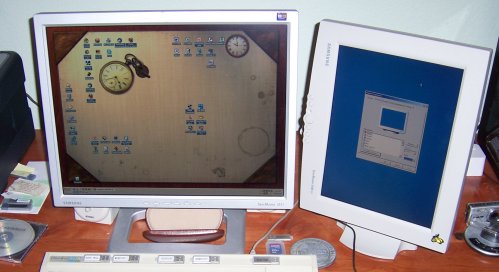
I got annoyed the other day (finally!) after being annoyed off and on since, well, almost forever. The problem was this: I was following a Web tutorial explaining how to do something in InDesign. I had InDesign up and maximized (as I always use it) and the Web tutorial in a Firefox window. Firefox wasn’t maximized, but that didn’t matter: Each time I selected a menu item in InDesign to tweak a setting, Firefox vanished under InDesign. That’s just the way Windows has always worked, and for a long time (ten years? more?) I was wondering if there were a better way. Tiling is not an option, not if I want to work on spreads in InDesign. So I just kept on keeping on, with Firefox appearing and vanishing as I ticked off steps on the tutorial.
Until this morning, when shadows on the wall told me that the light bulb had appeared over my head. Yes!
I ran downstairs and got an old monitor off the shelf. It’s a 15″ Samsung SyncMaster 570B, bought for Carol in 2003. She used it until I got her a 20″ display a couple of years ago. It has a mount pivot, and can be used in either portrait or landscape mode. I plugged it into the idle VGA video connector on my desktop, and without any fuss I had dual displays.
I’ve done that before to see how it was done, but never had the desk space for two identical (big) monitors. It wasn’t until today that I hit upon the refinement of putting the second monitor in portrait mode, which takes some space but not as much as anything in landscape mode. Now I can put a Firefox window on the secondary display while working on something full-screen on the primary display, without having to rescue the tutorial window from behind the app window each time I do something in the app window. Victory is sweet–and contains no fructose.
One peculiarity: My desktop wallpaper was partially duplicated on the second, lower-resolution display. The wallpaper image is a desktop blotter (complete with stains) and it just looked wrong having only part of it on the smaller monitor. I wanted the wallpaper on the primary display only, with just a blank color field on the secondary. Remarkably, there is no obvious way to do this. I dug around for most of an hour, trying things in both Control Panel’s Display applet and the NVidia control applet, without success. Then I hit upon this article. The gist is this:
- Return the wallpaper image setting in Display | Desktop to None; that is, turn off your current wallpaper. Both screens will now have the same blank color field for background.
- Select Desktop | Customize Desktop | Web. What you’re going to do is add a static image (the wallpaper of your choice) for Active Desktop, instead of a Web page.
- Click New. In the New Desktop Item dialog, click Browse, and select your wallpaper image from wherever it lives. Open it. Click OK on New Desktop Item. Click OK on the Web tab. Click OK on the Display applet as a whole to close it.
- The image you selected will be displayed, probably spanning both monitors. (It did on mine.) Hover over the top edge until the Active Desktop title bar pops up. Click and drag the image to whichever minotor you want to have it as wallpaper. When it’s moved completely onto one display, click the maximize button in the title bar. Bang! There’s your wallpaper, on one display only.
Now, as best I know Active Desktop was eliminated from Windows Vista, so this mechanism applies only to XP and (I presume) earlier versions. (Let me know if I’m wrong about that; I have no Vista or 7 instances here.) Active Desktop used a lot of CPU time and memory, but I think that was due to continuous refresh of the Active Desktop HTML and inane things like Pointcast that people have long forgotten. I don’t see any resource hit for having a static image in place of a Web page.
If I see any system flakiness in coming days I’ll reverse the change and let you know, but so far I haven’t seen a downside. I may try other uses of the secondary display, but I also think I may just turn it off unless I need to read a Web page while doing something else on the primary display. We’ll see.










